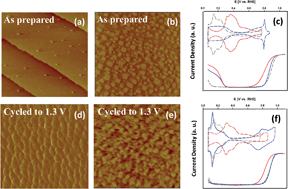Functional links between Pt single crystal morphology and nanoparticles with different size and shape: the oxygen reduction reaction case†
Abstract
Design of active and stable Pt-based nanoscale electrocatalysts for the oxygen reduction reaction (ORR) will be the key to improving the efficiency of fuel cells that are needed to deliver reliable, affordable and environmentally friendly energy. Here, by exploring the ORR on Pt single crystals, cubo-octahedral (polyhedral) Pt NPs with different sizes (ranging from 2 to 7 nm), and 7–8 nm Pt NPs with different shapes (cubo-octahedral vs. cube vs. octahedral), we presented a surface science approach capable of rationalizing, and ultimately understanding, fundamental relationships between stability of Pt NPs and activity of the ORR in acidic media. By exploring the potential induced dissolution/re-deposition of Pt between 0.05 and 1.3 V, we found that concomitant variations in morphology of Pt(111) and Pt(100) lead to narrowing differences in activity between Pt single crystal surfaces. We also found that regardless of an initial size or shape, NPs are metastable and easily evolve to thermodynamically equilibrated shape and size with very similar activity for the ORR. We concluded that while initially clearly observed, the particle size and shape effects diminish as the particles age to the point that it may appear that the ORR depends neither on the particle size nor particle shape.


 Please wait while we load your content...
Please wait while we load your content...